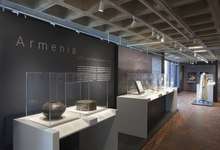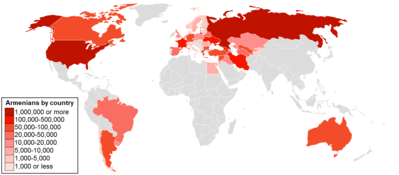Armenian Library and Museum of America
Armenian Library and Museum of America (ALMA), located in Watertown, Massachusetts, United States, is an institution that has the largest collection of Armenian artifacts in North America.
 | |

| |
| Established | 1971 to 1985 |
|---|---|
| Location | 65 Main Street, Watertown, Massachusetts |
| Coordinates | 42.36644°N 71.18582°W |
| Type | Armenian |
| Visitors | 3000 (annually) |
| Director | Berj Chekijian |
| Curator | Gary Lind-Sinanian Susan Lind-Sinanian (textile curator) |
| Public transit access | MBTA |
| Website | www |
History
In 1971, alarmed by the growing loss and destruction of Armenian books and artifacts brought to this country by immigrants from Armenia, a group of talented Greater Boston Armenian-Americans banded together to form ALMA to collect and preserve these books and artifacts. From humble beginnings in two rooms rented in 1972 in a church parish house in Belmont, ALMA grew and expanded into a Watertown church's 4,000-square-foot (370 m2) basement and opened to the public in 1985.
In 1988, ALMA was able to buy and remodel the former Coolidge Bank and Trust Building at 65 Main Street in Watertown. After being opened to the public as the Armenian Library and Museum of America, the building was dedicated to the memory of Stephen P. Mugar and Marian G. Mugar, his wife.
Building description
ALMA's present home is a four-story building plus basement containing approximately 30,000 square feet (2,800 m2). ALMA occupies all of the basement, the first and second floors, most of the third floor and has its library on the fourth floor. The building also houses the United States offices of the Armenia Tree Project, as well as the Armenian International Women's Association ("AIWA") and Project SAVE Armenian Photographic Archives.
Museum facilities
Bedoukian Hall is ALMA's main exhibit gallery. There are several smaller side galleries as well as the Contemporary Art Gallery and Terjenian-Thomas Art Gallery on the 3rd floor. Other facilities include the research library, studio space, offices, meeting rooms, classrooms, a 220-seat auditorium and a gift shop.
Museum collections
Armenian Museum of America (subdivision of ALMA) holds one of the largest and most diverse holding of Armenian cultural artifacts outside of Armenia. The Museum maintains an active program of changing exhibits for the public, to provide new experiences for returning visitors and to showcase the wide range of materials in the collection. The museum averages 14 different exhibits annually.
As a repository for heirlooms, the collections now represent a major resource for Armenian studies and for preservation and illustration of Armenian heritage. ALMA is the only independent Armenian museum in the diaspora, funded solely through contributions of individual supporters. An active board of trustees and volunteer base augment the museum’s four-member staff.
The collections contain over 20,000 artifacts, including:
- Countless artifacts including prehistoric, Urartian, religious, ceramic, medieval illuminations and various other objects;
- Over 5,000 ancient and medieval Armenian coins;
- Over 3,000 textiles: ALMA has one of the largest Armenian textile collections outside of Armenia. The trained textile curator, Susan Lind-Sinanian, has acted as a textile consultant to various institutions. The textiles are housed in climate-controlled space in the basement of the building. There they are also photographed, documented and cataloged.
- 930 rare books; and
- 170 Armenian rugs, many of which are inscribed in Armenian. The collection includes the Arthur T. Gregorian collection of Armenian inscribed rugs which he donated in 1992.
ALMA houses and sometimes displays the collected painting of Dr. Jack Kevorkian, the assisted suicide crusader, whose parents were Armenian refugees.[1]
Library
Armenian Library of America (subdivision of ALMA) is home to the Mesrob Boyajian Library. The Library contains over 26,000 cataloged titles on a wide range of Armenian subjects. The earliest is the Garabed Gospel of AD 1207. The library has one of the largest collections of important books on oriental rugs, and a very substantial collection, which continues to be expanded, on the Armenian Genocide. It also holds a significant number of periodicals.
The library is home to the Herbert Offen Oriental Carpet Research Library Collection, one of the most extensive collections of literature on oriental carpets in the United States. The Offen Family's generous gift includes both the books in the Herbert Offen Collection, as well as funding of acquisitions of new, recently published and antiquarian works related to the literature of rugs and carpets.
The Herbert Offen collection of over 2,500 volumes extends beyond the narrow focus on the types and development of Oriental rugs, and encompasses broader issues including the social implications of rug collecting, symbolism and theory, care and aesthetics, the commercial marketing and business of rugs, economic and domestic structures in carpet production, historical and contemporary use of rugs, and other textile traditions closely related to rugs.
Oral history collection
In the early 1970s, ALMA embarked on an extensive program of interviewing survivors of the Armenian Genocide, all or most of whom are now deceased. These tapes are digitized and de-noised. ALMA's collection consists of over 1,400 hours of recorded oral histories and is a fertile source for research by scholars.
References
- "Armenian Library and Museum of America". Atlas Obscura. Retrieved 2019-08-29.
